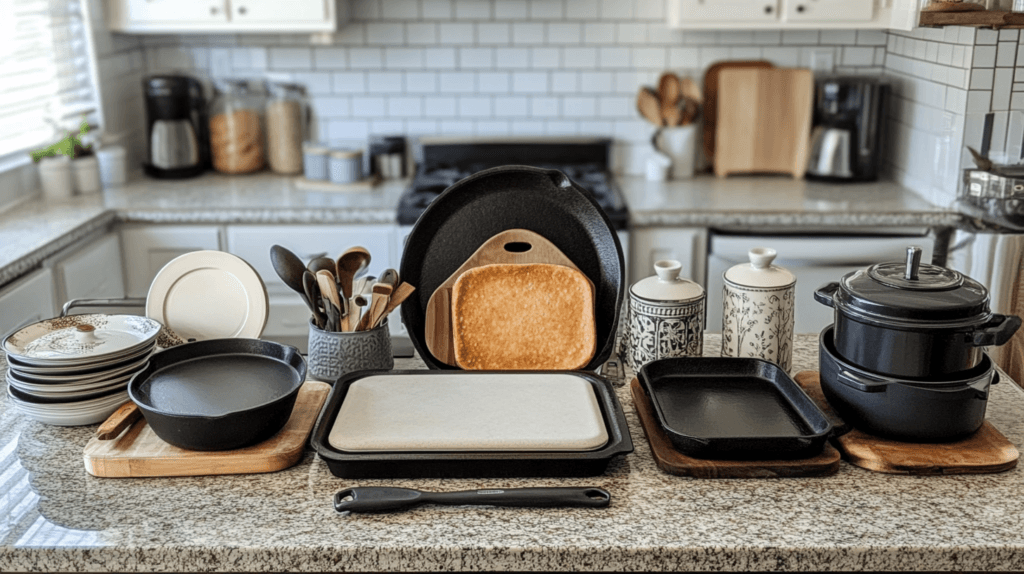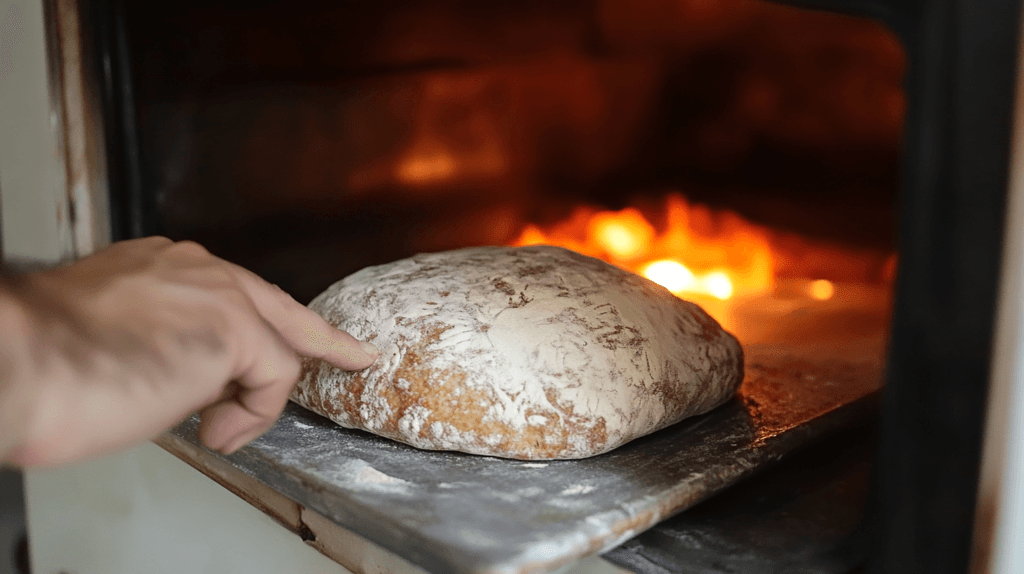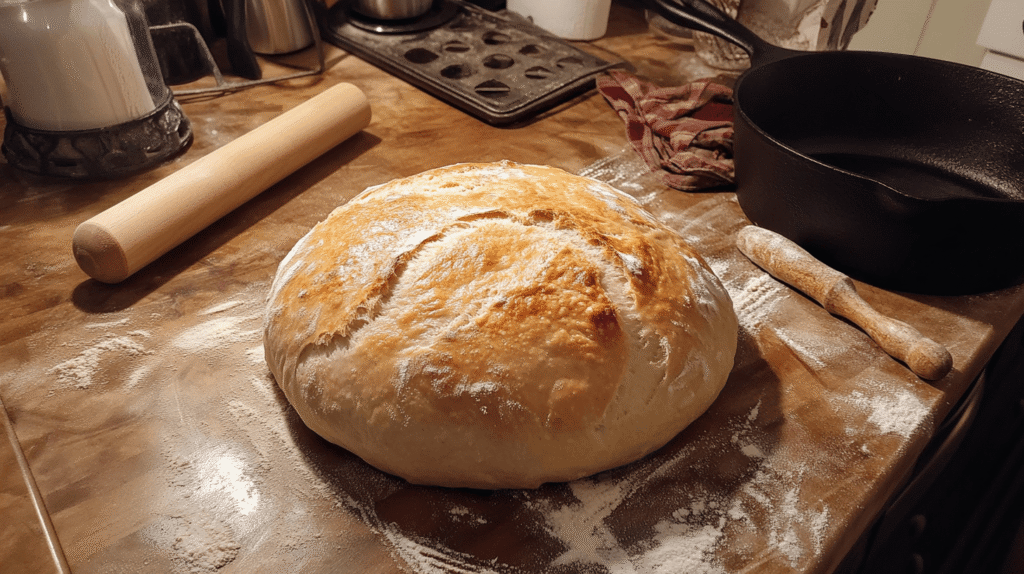Sourdough bread has captured the hearts (and ovens) of home bakers worldwide. Known for its tangy flavor, chewy texture, and satisfying crust, sourdough is a rewarding challenge for beginners and seasoned bakers alike. Traditionally, many recipes call for baking sourdough in a Dutch oven, as it helps retain steam and create the ideal environment to bake sourdough with a perfectly crisp crust and soft interior.
But what if you don’t have a Dutch oven? Whether you’re looking to avoid the expense, lack the storage space, or simply want to try something new, you can still bake an excellent sourdough loaf. In this guide, we’ll explore creative and effective methods for baking sourdough bread without a Dutch oven. Let’s get started!
Table of Contents
Understanding the Role of a Dutch Oven in Sourdough Baking
Before we dive into the alternatives, it’s essential to understand why a Dutch oven is commonly used in sourdough baking. This heavy-duty cookware offers:
- Steam Retention: The lid traps steam, which helps create that signature golden, blistered crust.
- Even Heat Distribution: Thick walls ensure consistent baking temperatures, preventing burnt bottoms or unevenly cooked loaves.
- High Heat Tolerance: Dutch ovens handle the intense temperatures required for sourdough baking.
However, Dutch ovens aren’t the only way to achieve these results. The key is to replicate these factors with accessible tools and techniques.
Essential Tools for How to Bake Sourdough Without a Dutch Oven

When you bake sourdough without a Dutch oven, the right tools can make all the difference. Here are some great alternatives:
Baking Trays and Pans
- Sturdy, heavy-duty baking trays or pans can act as a solid base for your sourdough loaf. They provide even support and transfer heat effectively.
Cast Iron Skillets
- A cast iron skillet offers excellent heat retention, much like a Dutch oven. It works particularly well if you pair it with a heatproof lid or foil to trap steam.
Ceramic or Clay Bakeware
- These materials mimic the thermal properties of a Dutch oven. They’re especially useful if you own a clay cloche, which can provide a similar sealed baking environment.
Pizza Stones
- A pizza stone absorbs and retains heat, ensuring an evenly baked loaf. While it doesn’t trap steam on its own, pairing it with steam-creating techniques works wonders.
Alternative Methods to Create Steam for Sourdough Bread
Steam plays a crucial role in sourdough baking, helping the bread expand during the initial oven spring phase and contributing to a crispy crust. Without a Dutch oven, here are some simple ways to introduce steam into your oven:
- Baking Tray with Water: Place a metal baking tray or pan on the bottom rack of the oven. Add hot water right after placing the bread in the oven to generate steam.
- Spraying Water Inside the Oven: Use a spray bottle filled with water to mist the walls of your oven as soon as you insert the dough. Repeat this process during the first 10 minutes of baking.
- Covering the Dough with a Heatproof Bowl: Use an inverted stainless steel or Pyrex bowl to cover the dough for the first half of the bake. This traps steam around the loaf, simulating the environment of a Dutch oven.
Preparing Your Sourdough Dough Without a Dutch Oven
Before diving into the alternative baking methods, it’s important to ensure your sourdough dough is well-prepared. Factors like hydration levels, proper proofing, and careful shaping play a critical role in the success of your loaf, especially when you bake sourdough without a Dutch oven to create the ideal baking environment.
1. Hydration Levels Matter
Hydration refers to the water-to-flour ratio in your sourdough recipe. Higher hydration levels (around 70-80%) typically result in a more open crumb structure and a thinner, crisper crust. If you’re baking without a Dutch oven, a slightly lower hydration level (65-70%) can make the dough easier to handle and prevent spreading during baking.
2. Kneading and Stretching Techniques
The gluten network in your dough is what gives it structure and elasticity. Use these methods to strengthen your dough:
- Stretch and Fold: Periodically stretching the dough and folding it over itself during the bulk fermentation phase strengthens the gluten and builds structure.
- Kneading: If you prefer, knead the dough until it feels smooth and elastic, which typically takes about 8-10 minutes.
3. Proofing: The Key to Flavor and Texture
Proper proofing allows the yeast and bacteria in your sourdough starter to ferment the dough, developing its characteristic flavor and rise. Follow these tips:
- Use a proofing basket (banneton) or a clean bowl lined with a floured towel to maintain the dough’s shape during the final proof.
- Refrigerating the dough overnight (cold fermentation) enhances the sourdough’s flavor and makes it easier to handle.
4. Shaping for Stability
When baking without a Dutch oven, shaping becomes even more critical. A well-shaped loaf holds its form and rises beautifully in the oven. Practice techniques like the “boule” (round loaf) or “batard” (oval loaf) shape for best results.
Alternative Baking Techniques for Sourdough Without a Dutch Oven

Baking sourdough without a Dutch oven requires some creative approaches, but with the right techniques, you can still bake sourdough that boasts an impressive crust, flavorful crumb, and professional-quality results.
Baking on a Pizza Stone
A pizza stone is a fantastic option for achieving a professional-quality sourdough loaf.
Steps for Success:
- Preheat the Stone: Place the stone on the center rack of your oven and preheat it for at least 45 minutes at 475°F (245°C).
- Transfer the Dough: Use parchment paper or a baker’s peel to transfer the shaped and proofed dough onto the hot stone.
- Create Steam: Simultaneously add a tray of hot water to the bottom rack or spray the oven walls with water.
- Bake with Care: Monitor the loaf closely to prevent overbrowning.
Using a Cast Iron Skillet
A cast iron skillet can be a versatile substitute for a Dutch oven, especially when paired with a steam-producing method.
Steps for Success:
- Preheat the Skillet: Heat the skillet in the oven for 30-40 minutes before baking.
- Transfer the Dough: Carefully place the dough into the preheated skillet, either with parchment paper or directly on the surface.
- Trap Steam: Cover the skillet with a heatproof lid, aluminum foil, or an inverted bowl during the first half of the bake.
- Finish Baking: Remove the cover for the last 15 minutes to allow the crust to crisp up.
Temperature Control for Baking Sourdough Without a Dutch Oven
Consistency is key when baking sourdough bread, particularly without a Dutch oven. Here’s how to manage your oven temperature effectively:
Preheating the Oven
- Always preheat your oven for at least 45 minutes. This ensures the oven walls and baking tools retain enough heat for an even bake.
Use an Oven Thermometer
- Oven temperature can vary from the setting displayed. An oven thermometer helps you confirm the exact temperature.
Adjust During the Bake
- Start at a high temperature (475°F/245°C) for the first 20 minutes, then lower it to around 425°F (220°C) to finish baking. This gradual decrease prevents the crust from burning while the loaf bakes through.
Crafting a Golden Crust Without a Dutch Oven
One of the hallmarks of sourdough bread is its crisp, golden crust. Achieving this without the steam-trapping capabilities of a Dutch oven requires a bit of creativity, but it’s entirely possible with the following strategies:
1. Use Steam Effectively
Steam helps the crust remain flexible during the first stages of baking, allowing the bread to expand fully. Here are reliable ways to create steam in your oven:
- Hot Water Method: Place a metal pan or baking tray on the lowest rack of your oven during preheating. When you place your sourdough loaf in the oven, pour about a cup of boiling water into the tray. The sudden burst of steam will envelop your bread.
- Damp Towels: Place damp (not dripping) kitchen towels on a baking sheet in the oven. The heat will create a steady stream of moisture.
- Spraying Water: Use a spray bottle to mist the oven walls and the top of the dough immediately after loading the bread.
2. Cover Your Dough
Using a heatproof bowl, foil, or large roasting pan to cover the dough for the first 20-25 minutes can replicate the steaming effect of a Dutch oven. This traps moisture from the dough itself, ensuring a shiny, blistered crust.
3. Bake to the Right Color
For a golden-brown crust:
- Leave the bread uncovered during the last 10-15 minutes of baking.
- Check the color frequently to prevent burning.
- Optionally, brush the crust with a bit of water or milk before baking to enhance its shine.
Troubleshooting Common Issues When Baking Sourdough Without a Dutch Oven
Baking sourdough without a Dutch oven can be a learning process. Here are some common problems and their solutions:
Flat Bread or Poor Rise
- Cause: Dough was under-proofed or lacked sufficient gluten development.
- Fix: Allow more time for proofing, particularly during cold fermentation. Ensure you knead or stretch the dough adequately during preparation.
Dough Sticking to Trays or Parchment
- Cause: Insufficient flouring or use of the wrong parchment paper.
- Fix: Dust your baking tray or parchment generously with flour, semolina, or cornmeal. Use high-quality parchment paper rated for high temperatures.
Uneven Crust or Burning
- Cause: Inconsistent oven temperature or placement of the bread.
- Fix: Use an oven thermometer and preheat thoroughly. Place the loaf in the center of the oven to ensure even heat distribution.
Crust Too Hard or Dry
- Cause: Lack of steam or overbaking.
- Fix: Use steam methods during the initial baking phase and monitor the bread’s color and texture closely.
Expert Tips for How to Bake Sourdough Without a Dutch Oven
Starting your sourdough journey without a Dutch oven may seem intimidating, but these tips can make the process smoother and more rewarding:
- Begin with Smaller Loaves
Smaller loaves are easier to handle and bake more evenly. A smaller dough mass also reduces the risk of spreading during baking. - Experiment with Hydration Levels
If you’re just starting, aim for a dough hydration level around 65-70%. As you gain confidence, try increasing the hydration for a more open crumb. - Practice Your Timing
Timing is everything in sourdough baking. Use a timer for each phase—bulk fermentation, proofing, and baking—to achieve consistency. - Use Quality Ingredients
Freshly milled flour and an active sourdough starter make all the difference. Ensure your starter is bubbly and ready before mixing your dough.
Benefits of Baking Without a Dutch Oven
While Dutch ovens are fantastic tools, baking without one has its own advantages:
- Accessibility: No need to invest in an expensive Dutch oven; you can use tools you likely already have at home.
- Cost-Effectiveness: Alternative methods are budget-friendly and just as effective with a bit of practice.
- Flexibility: Baking without a Dutch oven allows you to experiment with various tools and techniques, expanding your skills as a baker.
FAQs About Baking Sourdough Without a Dutch Oven
1. Can I bake sourdough in a regular pan?
Yes! Use cast iron skillets, baking trays, or cake pans paired with steam methods. For more inspiration, explore the ultimate guide to Dutch oven recipes.
2. What is the best way to create steam in the oven?
Adding hot water to a preheated metal tray or spraying water on oven walls works well. You can learn more in the expert guide on choosing the right Dutch oven size for bread.
3. Do I need special tools for sourdough baking?
Not necessarily. Tools like pizza stones or cast iron skillets are helpful, but you can achieve great results with basic bakeware and creative techniques.
4. How do I keep my bread from spreading?
Proper shaping and proofing help maintain structure. Consider slightly lowering the dough’s hydration level if spreading is a persistent issue.
5. Can I bake sourdough on parchment paper?
Yes, but make sure to use parchment rated for high temperatures to prevent sticking or burning.
6. How do I get a blistered crust without a Dutch oven?
Use methods like spraying water or covering the dough during the first half of the bake to trap steam, which encourages a blistered crust.
Conclusion
Baking sourdough without a Dutch oven fosters creativity and adaptability. Experimenting with alternatives not only expands your skills but also provides opportunities to perfect your craft. To understand how bakeware impacts results, explore the expert guide on choosing the right Dutch oven size for bread or read about Dutch oven sizes for sourdough.
Remember, sourdough baking is a journey. Embrace the process and enjoy each loaf you bake!
Additional Resources for Aspiring Bakers
To help you refine your sourdough skills, here are some resources and recommendations for further learning:
1. Recommended Recipes
- Beginner Sourdough Recipe: Start with a straightforward recipe featuring a lower hydration dough for easier handling.
- No-Knead Sourdough: Ideal for those who want minimal hands-on time while still achieving delicious results.
2. Tools to Consider
- Banneton (Proofing Basket): A game-changer for shaping and proofing your dough effectively.
- Lame (Bread Scoring Tool): Allows for creative scoring designs and helps the bread expand in the oven.
- Digital Kitchen Scale: Ensures precise measurements, which are crucial for sourdough success.
3. Join Sourdough Communities
- Online Forums: Platforms like Reddit’s r/Sourdough and The Fresh Loaf offer support and inspiration from fellow bakers.
- Social Media Groups: Instagram and Facebook have active sourdough communities where you can share your bakes and learn from others.
4. Books for Deeper Understanding
- “Tartine Bread” by Chad Robertson: A sourdough classic filled with detailed instructions and stunning photography.
- “Flour Water Salt Yeast” by Ken Forkish: A comprehensive guide for artisan bread making.
Final Thoughts
Mastering the art of baking sourdough without a Dutch oven is a rewarding journey. It encourages you to think outside the box and find creative solutions using tools you already have. Over time, you’ll develop techniques that suit your kitchen setup and personal preferences. Remember, each loaf is a learning experience—so enjoy the process, and savor the delicious results!
Printable Recipe Card
Want just the essential recipe details without scrolling through the article? Get our printable recipe card with just the ingredients and instructions.

